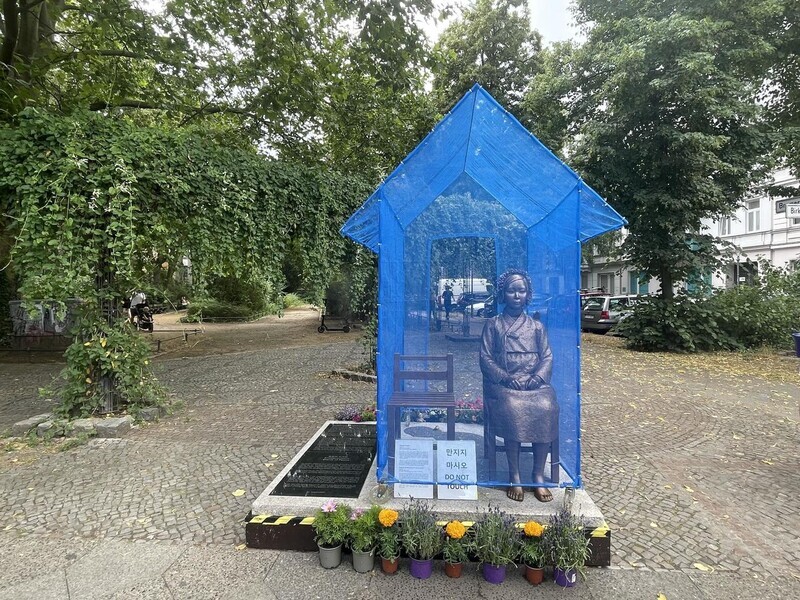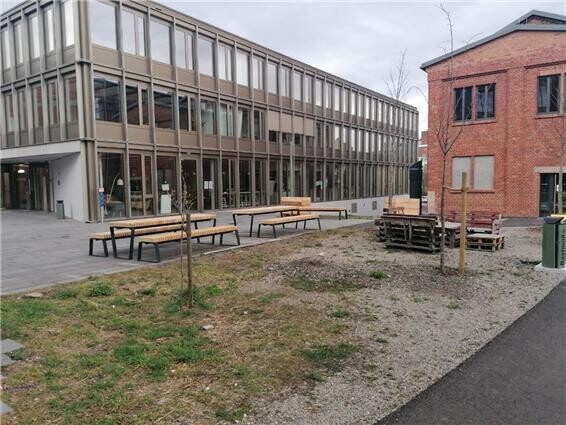hankyoreh
Links to other country sites 다른 나라 사이트 링크
[Interview] At German university, statue memorializing “comfort women” finds a home

“This Statue of Peace is a space of remembrance where we commemorate the pain of victims of wartime sexual crimes across the world. We also applaud the special courage of survivors who fought for their rights and dedicated their lives to making sure such crimes are never repeated.”
On Friday, a Statue of Peace with the above inscription in German was installed on the University of Kassel campus located in the state of Hessen, central Germany. The inscription also attested, “Japan’s wartime sexual crimes were brought to light by the testimony of the late Kim Hak-sun, who was the first to bear witness to her victimhood as a former ‘comfort women,’ on Aug. 14, 1991. This was an event that broke the decades-long silence of women victimized by wartime sexual violence.”
The Statue of Peace at the University of Kassel is the second of its kind installed on public land in Germany after the one that was erected in Berlin’s Mitte district in September 2020. In January, the university’s student council contacted Korea Verband, saying it had “learned about the difficult situation and issues surrounding the Statue of Peace in Berlin through the media” and that it “wanted to install a Statue of Peace on our campus to raise awareness [about the issue] among people worldwide.”
Kim Eun-sung and Kim Seo-kyung, the married artists behind the statue, heard the news and readily donated a statue to be erected at the university. The university’s headquarters issued a permanent authorization for the use of the installation space, allowing the statue to put down its roots at the location forevermore.
In an email interview with the Hankyoreh on Thursday, Tobias Schnoor, the head of the University of Kassel student council who led the effort that brought about the permanent installation of a Statue of Peace at his school, explained that “the Statue of Peace is both a symbol and remembrance of resistance against wrongful history.”
The significance of the Statue of Peace’s permanent installationHankyoreh: What do you think is the significance of a Statue of Peace that has taken root at a German university campus?Tobias Schnoor: The Statue of Peace symbolizes not only the tens of thousands of women who suffered oppression at the hands of Japan during WWII but also the women who experience sexual violence in Europe [due to their race] currently. They were physically and mentally trampled on just because they were women and vulnerable. The statue demonstrates not just the will to constantly resist such histories but also the will to remember them. This is why it will remain in Kassel on a permanent basis.
Hani: What specifically brought about the installation?Schnoor: Last year, I learned through the media that the Japanese government was pressuring for the removal of the Statue of Peace in Berlin. I was deeply moved by the resistance waged by the Korean community in Berlin as well as groups in solidarity with it, which is why I studied and examined the history related to the issue.

Schnoor: We thought that if the statue weren’t permanently preserved, the perpetrators might organize for its removal. Plus, as home to Documenta, an international contemporary art festival that draws over 5 million visitors yearly, Kassel is a location that garners international attention. With the statue installed in such a conspicuous public space, the perpetrators will not be able to ignore the statue’s existence nor try to get it removed.
Hani: There must have been a lot of difficulties in the installation process.Schnoor: Our first concern was regarding continuity. We wanted to find a way to consistently raise awareness of the issue of forced sexual slavery and state violence through the Statue of Peace and also allow the next generation of students to consistently work on projects related to the statue. The installation cost was also a problem. Without the donation of the statue by its creators and the help of Korea Verband, the installation would not have been possible.
The Statue of Peace depicts a girl who looks about 13 to 14 years old and has a youthful face and a short bob. Dressed in a chimajeogori, she is barefoot. Her life trampled by soldiers, she was unable to spread her roots into the earth, her sadness embodied by her raised heels. But a bird of peace quietly sits on her shoulder. And this time, on the empty space next to her, the young students of the University of Kassel in Germany lay down their solidarity.
Hani: There were attempts to remove statues dedicated to the “comfort women” in Berlin and Dusseldorf due to pressure from the Japanese government. What if something similar happens in Kassel?Schnoor: Kassel is an anti-fascist city. We already have experience proactively fighting against neo-Nazis and conspiracy theorists. We are trained to resist reactionary thought. Actions like attempts to get the statue removed will not get traction here. Additionally, the statue embodies important historical information, scholarship, and is a work of art. German universities are public spaces where academic freedom is guaranteed. No country’s embassy or government nor fascists will be able to remove the statue from campus. If that happens, more Statues of Peace will be installed at the university. We are not afraid of pressure from them.
Hani: Germany has its own painful history of being a perpetrator of war crimes. Based on historical experience, how should Japan go about settling its colonial legacy?Schnoor: Due to the Holocaust, Germany has an established “culture of remembrance.” But discrimination still exists in regard to the recognition victims of the Nazi regime receive. Like during Japanese colonialism, tens of thousands of women were forced into sexual slavery, their human dignity trampled upon. But even in Germany, they are not researched into or commemorated.
No society can overcome colonialism on its own. [Countries that perpetrated crimes of imperialism] grapple with the task of having to properly remember, understand, and be conscious of their own guilt. Other countries that perpetrated colonialism also do not recognize historical facts because of the shame they feel about the crimes they committed. Because colonialism is a structure of systemic racist social inequality, those countries neither understand nor attempt to understand that what they did were crimes. Our goal is to continuously explain this point and educate. We all still have a lot to learn.
What the Statue of Peace can doRecently in Germany, Korean far-right groups and figures such as ROK Mothers Unit leader Joo Ok-soon have been holding protests demanding the removal of the Statue of Peace in Berlin-Mitte. In response, the Korean Council for Justice and Remembrance for the Issues of Military Sexual Slavery by Japan and the German civic group Korea Verband collected signatures of 31,317 individuals and 559 civic groups in Korea and abroad in support of the preservation of the statue, sending them to the Mitte District Office.
Schnoor explained that although he is well aware of concerns that conservative groups may attempt to pressure authorities to remove the Statue of Peace installed at the university, just like they have been doing with the one in Berlin, he believes similar “obstructive measures” will be difficult, as the statue in Kassel is located in a space inside the university used by hundreds of students daily.
Hani: What other activities related to the Statue of Peace are being planned?Schnoor: On Saturday, the day after the unveiling ceremony for the statue, there will be a presentation titled “There is no social consensus that this is a crime” by Regina Mühlhäuser, a scholar of wartime sexual violence, during a scholarly event. Starting next semester, we will be preparing educational and training programs on issues related to victims of sexual violence, especially wartime sexual violence. The Statue of Peace will be at the center of such activities going forward.
By Nam Eun-joo, special contributor in Berlin; Hong Seock-jae, staff reporter
Please direct questions or comments to [english@hani.co.kr]

Editorial・opinion
![[Editorial] Penalties for airing allegations against Korea’s first lady endanger free press [Editorial] Penalties for airing allegations against Korea’s first lady endanger free press](https://flexible.img.hani.co.kr/flexible/normal/500/300/imgdb/original/2024/0502/1817146398095106.jpg) [Editorial] Penalties for airing allegations against Korea’s first lady endanger free press
[Editorial] Penalties for airing allegations against Korea’s first lady endanger free press![[Editorial] Yoon must halt procurement of SM-3 interceptor missiles [Editorial] Yoon must halt procurement of SM-3 interceptor missiles](https://flexible.img.hani.co.kr/flexible/normal/500/300/imgdb/child/2024/0501/17145495551605_1717145495195344.jpg) [Editorial] Yoon must halt procurement of SM-3 interceptor missiles
[Editorial] Yoon must halt procurement of SM-3 interceptor missiles- [Guest essay] Maybe Korea’s rapid population decline is an opportunity, not a crisis
- [Column] Can Yoon steer diplomacy with Russia, China back on track?
- [Column] Season 2 of special prosecutor probe may be coming to Korea soon
- [Column] Park Geun-hye déjà vu in Yoon Suk-yeol
- [Editorial] New weight of N. Korea’s nuclear threats makes dialogue all the more urgent
- [Guest essay] The real reason Korea’s new right wants to dub Rhee a founding father
- [Column] ‘Choson’: Is it time we start referring to N. Korea in its own terms?
- [Editorial] Japan’s rewriting of history with Korea has gone too far
Most viewed articles
- 1Months and months of overdue wages are pushing migrant workers in Korea into debt
- 2[Editorial] Penalties for airing allegations against Korea’s first lady endanger free press
- 3Bills for Itaewon crush inquiry, special counsel probe into Marine’s death pass National Assembly
- 4Trump asks why US would defend Korea, hints at hiking Seoul’s defense cost burden
- 560% of young Koreans see no need to have kids after marriage
- 6S. Korea discusses participation in defense development with AUKUS alliance
- 7[Reporter’s notebook] In Min’s world, she’s the artist — and NewJeans is her art
- 8Korean firms cut costs, work overtime amid global economic uncertainties
- 91 in 3 S. Korean security experts support nuclear armament, CSIS finds
- 10[Guest essay] Maybe Korea’s rapid population decline is an opportunity, not a crisis